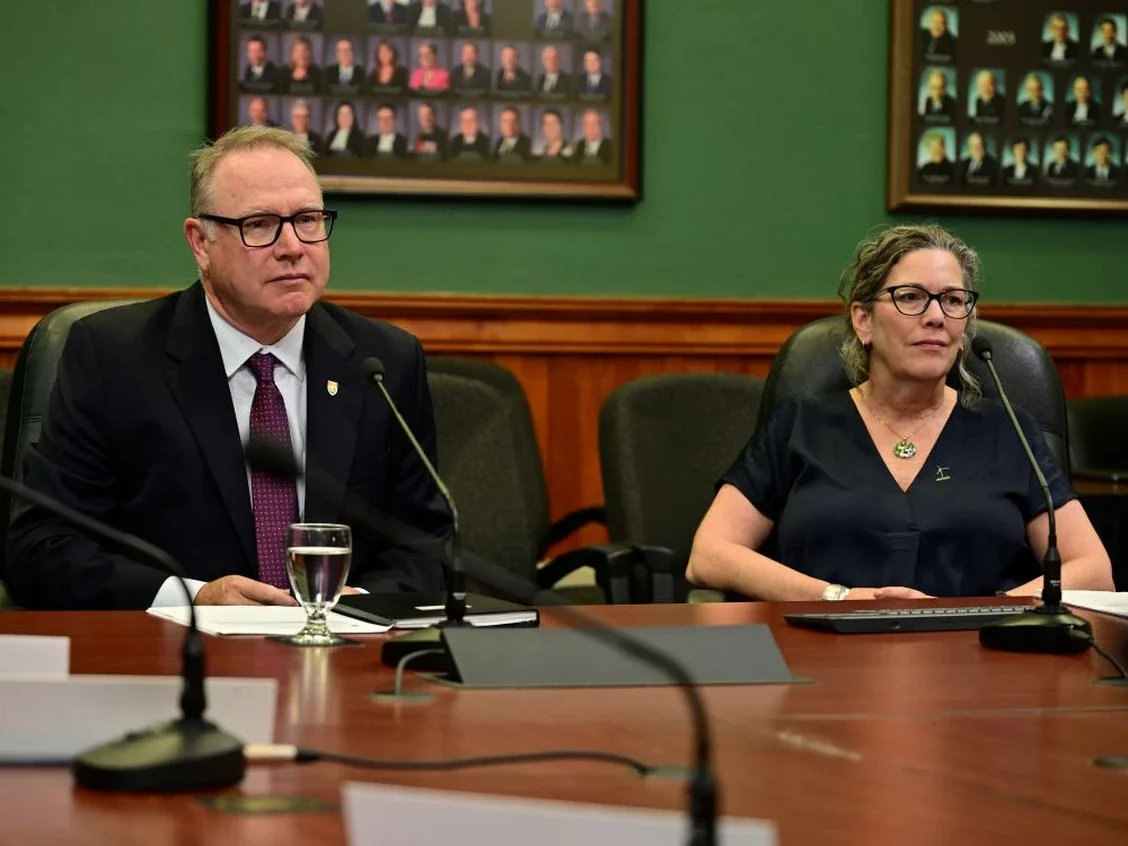Nov 02, 2025 Article By Yutaro Sasaki, published by The Guardian
Legislative committee hears about electricity production and storage in the province
P.E.I. Energy Corporation CEO Gordon MacFadyen, left, and director Heather MacLeod appear before the natural resources and environmental sustainability standing committee on Oct. 23. Photo by Yutaro Sasaki /Local Journalism Initiative
As P.E.I. looks for ways to get the electricity it needs, the director of the province’s energy corporation says the Island has world-class wind energy resources.
P.E.I. Energy Corporation director Heather MacLeod was one of the presenters during a natural resources and environmental sustainability standing committee on Oct. 23 where she discussed the province’s renewable energy efforts.
The P.E.I. Energy Corporation is a provincial Crown corporation with a mandate to promote and develop energy systems on the Island.
“Wind development was the obvious choice if we wanted to do local electricity generation and wind is nice in that it meets the strategic objectives of our energy policy,” she said.
As energy produced from wind is renewable and non-emitting, what people often forget is that it also enables economic opportunities in rural areas in P.E.I., MacLeod added.
Wind turbines
In the past, the province’s environmental committee inquired about the potential for expanding various renewable energy and storage technologies.
During the Oct. 23 meeting, MacLeod suggested that, given the extensive experience gained with wind technology, expanding its capabilities is where decision-makers should look first.
“But diversity of resources is also valuable, and technology is changing every day. So ongoing research is a part of what we do at the energy corporation and within the government,” she added.
P.E.I.'s new energy strategy aims to ensure the province's power grid is more reliable, more affordable and more climate-friendly.
P.E.I.’s new energy strategy underlines affordability concerns, endorses fossil fuel turbines
A solar farm built in 2018 at the Cavendish Farms Wellness Centre in Three Rivers, P.E.I., is an example of an alternative energy source that chief administrative officer John Jamieson hopes to see more of through a Quest initiative the town is participating in. - Yutaro Sasaki/Local Journalism Initiative
How P.E.I. communities aim for net-zero emissions by 2050
“We’ve been working with wind turbines for over 20 years and we’re still seeing innovation,” she added.
As wind turbines increase in size, MacLeod said there have been changes made to reduce noise, thereby minimizing their impact on nearby communities.
Innovating technologies have also allowed new wind turbines in P.E.I. to reduce their use of lubricants, she added.
“The wind industry seems to have settled on that standard three-bladed form. In years past, there were many different formats for wind turbines,” said MacLeod.
Wind Energy Institute of Canada is also continuing its valuable research programs, she added.
At the moment, the institute is considering end-of-life options for its assets, including whether to re-power or extend their lifetime, said MacLeod.
“And they’re really looking at increasing grid integration of renewables and energy storage,” she said.
Solar power
Currently, both the energy corporation and Summerside’s utility are in the early stages of learning and utilizing solar energy along with utility-scale solar, MacLeod said.
Additionally, the positive impact has been evident in the way customers of the utilities have quickly adopted small solar, also known as behind-the-meter solar, she added.
“Over the past few years, there’ve been federal and provincial rebates available, and we’ve seen over 50 MW of solar installed at homes and businesses on the island,” said MacLeod.
The size of the province, being an island, also limits the number of solar panels that can be installed on P.E.I.
In building a solar farm, land requirements could be tenfold in producing a similar energy output compared to a wind farm, MacLeod added.
“We quickly discovered with our Slemon Park project that solar, the sheer size, and the amount of land needed for solar energy are significant,” said MacLeod.
Geothermal energy
Geology was not kind to P.E.I. from the perspective of utilizing geothermal technology, said MacLeod.
“There was a study done in 1983 that a fairly deep hole was drilled in Charlottetown just to try and quantify what geothermal uptake opportunity there was here,” she said.
The study results were disappointing, MacLeod added.
That said, further research on its technology has enabled the corporation to heat its own building in Hermanville, as well as a few public buildings on P.E.I., using geothermal systems, she said.
“In some smaller installations, it makes sense, especially when I think of schools, because it’s not just a heating system, it’s a cooling system as well,” said MacLeod.
As Prince Edward Island incrementally gets warmer, cooling is becoming more of a factor for some people, she added.
“And as we look to make our energy systems more sustainable, we’re constantly monitoring what other jurisdictions are doing, evaluating the potential for technologies that might work on the island,” she said.
Yutaro Sasaki is a Local Journalism Initiative reporter, a position funded by the federal government. He can be reached at ysasaki@postmedia.com and followed on X @PEyutarosasaki.

